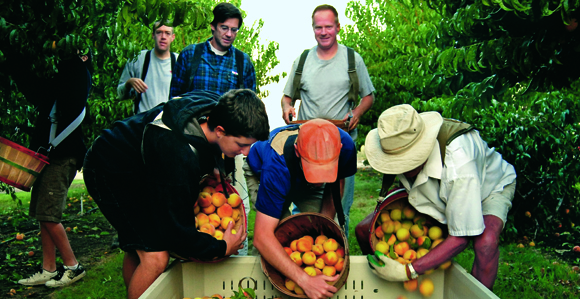Another "Bumper Year" on Church Farms and Ranches
Contributed By By Jason Swensen, Church News staff writer

Volunteers help harvest peaches at the Church-owned North Ogden Peach Orchard.
Article Highlights
- Welfare officials are calling 2013 another “bumper” year thanks largely to the efforts of thousands of Latter-day Saint volunteers.
- Much of the foodstuff that helps define the welfare program continues to be produced on Church farms, orchards, and ranches.
“All we ask for is a willing heart and a strong back.” —Wade Sperry, agricultural specialist in the Church’s welfare department.
Related Links
A few years ago, a Harvard University professor contacted Wade Sperry, an agricultural specialist in the Church’s welfare department.
The professor explained that he was working on a case study about the welfare department’s vast and varied agricultural projects. He asked if he could spend a few days visiting Church-owned farms, orchards, and beef ranches.
Brother Sperry accompanied the professor and a team of graduate students on their agricultural tour. At each locale, the Harvard contingent witnessed crews of happy volunteers picking fruit, harvesting crops, and wrangling cattle.
They returned to Boston both humbled and inspired by the charitable spirit of cooperation and compassion they found in each volunteer who donated time and muscle to produce food that would feed families in need.
A short time later, the professor sent Brother Sperry a copy of his case study on the Church welfare agricultural projects.
“He wrote that there is nothing like this anywhere on earth—it’s unique,” said Brother Sperry.
Since 1936, the Church’s renowned welfare program has blessed lives worldwide. Much of the foodstuff that helps define the welfare program continues to be produced on Church farms, orchards, and ranches.
Welfare officials are calling 2013 another “bumper” year thanks largely to the efforts of thousands of Latter-day Saint volunteers. Here are a few highlights of what’s happened over the past 12 months on Church-owned agricultural projects, including expected yields.
• Fifty farms and orchards located across the United States and Canada produced some 83 million pounds of wheat and dry beans; 6 million pounds of fruit (apples, peaches and pears); 250,000 pounds of fresh vegetables; and 20 million pounds of row crops such as sugar beets.

Harvesting green beans from a welfare farm in Layton, Utah.
• An LDS-owned turkey farm in Moroni, Utah, yielded 5 million pounds of turkey.
• The Church-owned vineyard in Madera, Calif., produced several tons of raisins.
• The Church’s peanut farm in Texas supplied the essential ingredient for the Church to produce its own protein-rich peanut butter.
• The Church’s five working cattle ranches—staffed largely by “cowboy” missionaries—yielded hamburger and other fresh beef products that stocked the meat section of bishops’ storehouses.

The Deseret Dairy Farm in Elberta, Utah.
The past year’s food production numbers are impressive. But the most uplifting figure, said Brother Sperry, is again the volunteer labor hours recorded at the many farms and ranches.
In 2012, volunteers performed some 350,000 hours of labor. That number is expected to be matched by the end of 2013.
The volunteers who reported for duty on the welfare farms, orchards and vineyard are a varied lot. A few are missionary couples assigned to a specific project. But the vast majority are men, women, youth, and children from all backgrounds who simply answered the call to practice “pure religion.”
Most volunteer workers had little background in agriculture. Not a problem, said Brother Sperry. “All we ask for is a willing heart and a strong back.”
The Book of Mormon prophet Jacob taught that one who has “obtained a hope in Christ” will seek “to feed the hungry” and “administer relief to the sick and the afflicted” (Jacob 2:18-19).
Brother Sperry and other welfare officials consider Jacob’s words every time they witness, say, a young family or a carload of young men and young women sling bags across their shoulders and begin picking grapes or peaches.
“They know the fundamental purpose of the Church,” he said.
Brother Sperry also noted the pivotal role that agent stakes play in organizing volunteer efforts. It’s no small task mobilizing hundreds of workers when apples are ready for picking or beans are ripe for harvest.
Even as the winter snow covers many of the Church farms and orchards, welfare officials look to 2014 for more opportunities to feed those in need. In his definitive book Pure Religion: The Story of Church Welfare Since 1930, Elder Glen L. Rudd writes that the Church’s welfare program remains the Lord’s plan to care for the poor and needy:
“This work will continue, and lives will be blessed through the united efforts of faithful, charitable members of the Lord’s living Church.”
